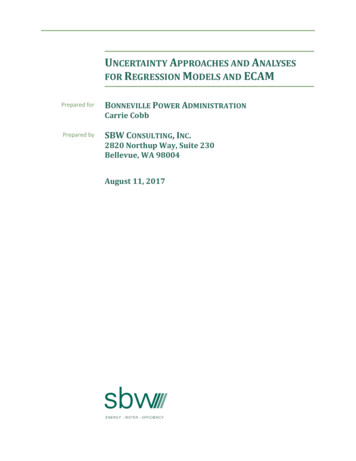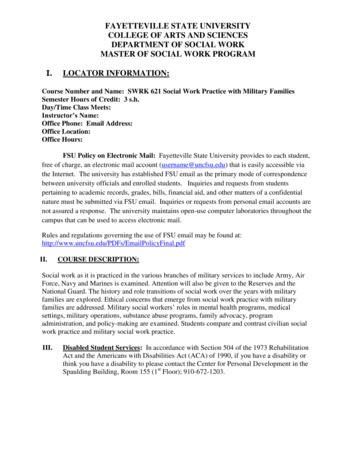
Transcription
LECTURE 5Advanced Functionsand OOP
FUNCTIONS Before we start, let’s talk about how name resolution is done in Python: When a function executes, a newnamespace is created (locals). New namespaces can also be created by modules, classes, and methods aswell. LEGB Rule: How Python resolves names. Local namespace. Enclosing namespaces: check nonlocal names in the local scope of any enclosing functions from inner toouter. Global namespace: check names assigned at the top-level of a module file, or declared global in a defwithin the file. builtins : Names python assigned in the built-in module. If all fails: NameError.
FUNCTIONS AS FIRST-CLASS OBJECTS We noted a few lectures ago that functions are first-class objects in Python. What exactlydoes this mean? In short, it basically means that whatever you can do with a variable, you can do with afunction. These include: Assigning a name to it. Passing it as an argument to a function. Returning it as the result of a function. Storing it in data structures. etc.
FUNCTION FACTORY a.k.a. Closures. As first-class objects, you can wrapfunctions within functions. Outer functions have free variablesthat are bound to inner functions. A closure is a function object thatremembers values in enclosingscopes regardless of whether thosescopes are still present in memory.def make inc(x):def inc(y):# x is closed in# the definition of increturn x yreturn incinc5 make inc(5)inc10 make inc(10)print(inc5(5)) # returns 10print(inc10(5)) # returns 15
CLOSURE Closures are hard to define so follow these three rules for generating a closure:1. We must have a nested function (function inside a function).2. The nested function must refer to a value defined in the enclosing function.3. The enclosing function must return the nested function.
DECORATORS Wrappers to existingfunctions.def say hello(name):return "Hello, " str(name) "!" You can extend thefunctionality of existingfunctions withouthaving to modify them.def p decorate(func):def func wrapper(name):return " p " func(name) " /p "return func wrappermy say hello p decorate(say hello)print (my say hello("John"))# Output is: p Hello, John! /p
DECORATORS Wrappers to existingfunctions.def say hello(name):return "Hello, " str(name) "!" You can extend thefunctionality of existingfunctions withouthaving to modify them.def p decorate(func):def func wrapper(name):return " p " func(name) " /p "return func wrapperClosuremy say hello p decorate(say hello)print (my say hello("John"))# Output is: p Hello, John! /p
DECORATORS So what kinds of things can we use decorators for? Timing the execution of an arbitrary function. Memoization – cacheing results for specific arguments. Logging purposes. Debugging. Any pre- or post- function processing.
DECORATORS Python allows us some nicesyntactic sugar for creatingdecorators.Notice here how we have to explicitlydecorate say hello by passing it toour decorator function.def say hello(name):return "Hello, " str(name) "!"def p decorate(func):def func wrapper(name):return " p " func(name) " /p "return func wrappermy say hello p decorate(say hello)print (my say hello("John"))# Output is: p Hello, John! /p
DECORATORS Python allows us some nicesyntactic sugar for creatingdecorators.Some nice syntax thatdoes the same thing,except this time I canusesay hello instead ofassigning a newname.def p decorate(func):def func wrapper(name):return " p " func(name) " /p "return func wrapper@p decoratedef say hello(name):return "Hello, " str(name) "!"print (say hello("John"))# Output is: p Hello, John! /p
DECORATORS You can also stack decorators with the closest decorator to the function definitionbeing applied first.@div decorate@p decorate@strong decoratedef say hello(name):return “Hello, ” str(name) “!”print (say hello("John"))# Outputs div p strong Hello, John! /strong /p /div
DECORATORS We can also pass arguments to decorators if we’d like.def tags(tag name):def tags decorator(func):def func wrapper(name):return " " tag name " " func(name) " /" tag name " "return func wrapperreturn tags decorator@tags("p")def say hello(name):return "Hello, " str(name) "!"print (say hello("John"))# Output is: p Hello, John! /p
DECORATORS We can also pass arguments to decorators if we’d like.def tags(tag name):def tags decorator(func):def func wrapper(name):return " " tag name " " func(name) " /" tag name " "return func wrapperreturn tags decoratorClosure!@tags("p")def say hello(name):return "Hello, " str(name) "!"print (say hello("John"))
DECORATORS We can also pass arguments to decorators if we’d like.def tags(tag name):def tags decorator(func):def func wrapper(name):return " " tag name " " func(name) " /" tag name " "return func wrapperreturn tags decorator@tags("p")def say hello(name):return "Hello, " str(name) "!"print (say hello("John"))More Closure!
ACCEPTS EXAMPLE Let’s say we wanted to create a general purpose decorator for the commonoperation of checking validity of function argument types.import math def complex magnitude(z):return math.sqrt(z.real**2 z.imag**2) complex magnitude("hello")Traceback (most recent call last):File " stdin ", line 1, in module File "accepts test.py", line 4, in complex magnitudereturn math.sqrt(z.real**2 z.imag**2)AttributeError: 'str' object has no attribute 'real' complex magnitude(1 2j)2.23606797749979
ACCEPTS EXAMPLEdef accepts(*arg types):def arg check(func):def new func(*args):for arg, arg type in zip(args,arg types):if type(arg) ! arg type:print ("Argument", arg, "is not of type", arg type)breakelse:func(*args)return new funcreturn arg checkCheck out accepts test.py!
OOP IN PYTHON Python is a multi-paradigm language and, as such, supports OOP as well as a varietyof other paradigms. If you are familiar with OOP in C , for example, it should be very easy for you topick up the ideas behind Python’s class structures.
CLASS DEFINITION Classes are defined using the class keyword with a very familiar structure:class ClassName(object): statement-1 . . . statement-N There is no notion of a header file to include so we don’t need to break up thecreation of a class into declaration and definition. We just declare and use it!
CLASS OBJECTS Let’s say I have a simple class which does not much of anything at all.class MyClass(object):""""A simple example class docstring"""i 12345def f(self):return 'hello world' I can create a new instance of MyClass using the familiar function notation.x MyClass()
CLASS OBJECTS I can access the attributes andmethods of my object in the following way: x MyClass() x.i12345 x.f()'hello world' We can define the special method init () which is automatically invoked fornew instances (initializer).class MyClass(object):"""A simple example class"""i 12345def init (self):print ("I just created a MyClass object!" )def f(self):return 'hello world'
CLASS OBJECTS Now, when I instantiate a MyClass object, the following happens: y MyClass()I just created a MyClass object! We can also pass arguments to our init function: class Complex(object):.def init (self, realpart, imagpart):.self.r realpart.self.i imagpart x Complex(3.0, -4.5) x.r, x.i(3.0, -4.5)
DATA ATTRIBUTES Like local variables in Python, there is no need for a data attribute to be declaredbefore use. class Complex(object):.def init (self, realpart, imagpart):.self.r realpart.self.i imagpart x Complex(3.0, -4.5) x.r, x.i(3.0, -4.5) x.r squared x.r**2 x.r squared9.0
DATA ATTRIBUTES We can add, modify, or delete attributes at will.x.year 2016 # Add an ‘year' attribute.x.year 2017 # Modify ‘year' attribute.del x.year# Delete ‘year' attribute. There are also some built-in functions we can use to accomplish the same r')#'year')#'year', 2017) #'year')#Returns true if year attribute existsReturns value of year attributeSet attribute year to 2015Delete attribute year
VARIABLES WITHIN CLASSES Generally speaking,variables in a class fallunder one of two categories: Class variables, which areshared by all instances. Instance variables, whichare unique to a specificinstance. class Dog(object):.kind 'canine' # class var.def init (self, name):.self.name name # instance var d Dog('Fido') e Dog('Buddy') d.kind # shared by all dogs'canine' e.kind # shared by all dogs'canine' d.name # unique to d'Fido' e.name # unique to e'Buddy'
VARIABLES WITHIN CLASSES Be careful when using mutable class Dog(object): tricks [] # mutable class variableobjects as class variables. def init (self, name): self.name name def add trick(self, trick): self.tricks.append(trick) d Dog('Fido') e Dog('Buddy') d.add trick('roll over') e.add trick('play dead') d.tricks # unexpectedly shared by all['roll over', 'play dead']
VARIABLES WITHIN CLASSES To fix this issue, make it aninstance variable instead. class Dog(object): def init (self, name): self.name name self.tricks [] def add trick(self, trick): self.tricks.append(trick) d Dog('Fido') e Dog('Buddy') d.add trick('roll over') e.add trick('play dead') d.tricks['roll over'] e.tricks['play dead']
BUILT-IN ATTRIBUTESBesides the class and instance attributes, every class has access to the following: dict : dictionary containing the object’s namespace. doc : class documentation string or None if undefined. name : class name. module : module name in which the class is defined. This attribute is" main " in interactive mode. bases : a possibly empty tuple containing the base classes, in the order of theiroccurrence in the base class list.
METHODS We can call a method of a class object using the familiar function call notation. x MyClass() x.f()'hello world' Perhaps you noticed, however, that the definition of MyClass.f() involves an argumentcalled self.class MyClass(object):"""A simple example class"""i 12345Calling x.f() is equivalentdef init (self):to calling MyClass.f(x).print ("I just created a MyClass object!“)def f(self):return 'hello world'
FRACTION EXAMPLE Check out Bob Myers’ simple fraction class here. Let’s check out an equivalent simple class in Python (frac.py).
FRACTION EXAMPLE 0 1 3 5import fracf1 frac.Fraction()f2 frac.Fraction(3,5)f1.get numerator()f1.get denominator()f2.get numerator()f2.get denominator()
FRACTION EXAMPLE f2.evaluate()0.6 f1.set value(2,7) f1.evaluate()0.2857142857142857 f1.show()2/7 f2.show()3/5 f2.input()2/3 f2.show()2/3
PET EXAMPLE Here is a simple class that defines a Pet object.class Pet(object):def init (self, name, age):self.name nameself.age ageThe str built-in functiondef get name(self):defines what happens when Ireturn self.nameprint an instance of Pet. Heredef get age(self):I’mreturn self.ageoverriding it to print thedef str (self):name.return "This pet’s name is " str(self.name)
PET EXAMPLE Here is a simple class that defines a Pet object. from pet import Pet mypet Pet('Ben', '2') print (mypet)This pet's name is Ben mypet.get name()'Ben' mypet.get age()2class Pet(object):def init (self, name, age):self.name nameself.age agedef get name(self):return self.namedef get age(self):return self.agedef str (self):return "This pet’s name is " str(self.name)
INHERITANCE Now, let’s say I want to create a Dog class which inherits from Pet. The basic formatof a derived class is as follows:class DerivedClassName(BaseClassName): statement-1 . statement-N In the case of BaseClass being defined elsewhere, you can usemodule name.BaseClassName.
INHERITANCE Here is an example definition of a Dog class which inherits from Pet.class Dog(Pet):pass The pass statement is only included here for syntax reasons. This class definition forDog essentially makes Dog an alias for Pet.
INHERITANCE We’ve inherited all the functionality of our Pet class, now let’s make the Dog classmore interesting. from dog import Dog mydog Dog('Ben', 2) print (mydog)This pet's name is Ben mydog.get name()'Ben' mydog.get age()2class Dog(Pet):pass
INHERITANCE For my Dog class, I want all of the functionality of the Pet class with one extraattribute: breed. I also want some extra methods for accessing this attribute.class Dog(Pet):def init (self, name, age, breed):Pet. init (self, name, age)self.breed breeddef get breed(self):return self.breed
INHERITANCE For my Dog class, I want all of the functionality of the Pet class with one extraattribute: breed. I also want some extra methods for accessing this attribute.class Dog(Pet):def init (self, name, age, breed):Pet. init (self, name, age)self.breed breeddef get breed(self):return self.breedOverriding initialization functionPython resolves attribute and method referencesby firstsearching the derived class and then searchingthe base class.
INHERITANCE For my Dog class, I want all of the functionality of the Pet class with one extraattribute: breed. I also want some extra methods for accessing this attribute.class Dog(Pet):def init (self, name, age, breed):Pet. init (self, name, age)self.breed breeddef get breed(self):return self.breedself.name nameself.age ageWe can call base class methods directly usingBaseClassName.method(self, arguments). Note that we do this hereto extend the functionality of Pet’s initialization method.
INHERITANCE from dog import Dog mydog Dog('Ben', 2, 'Maltese') print (mydog)This pet's name is Ben mydog.get age()2 mydog.get breed()class Dog(Pet):'Maltese'def init (self, name, age, breed):Pet. init (self, name, age)self.breed breeddef get breed(self):return self.breed
INHERITANCE Python has two notable built-infunctions: isinstance(obj, cls) returns trueif obj is an instance of cls (or some classderived from cls). issubclass(class, classinfo)returns true if class is a subclass ofclassinfo. from pet import Pet from dog import Dog mydog Dog('Ben', 2, 'Maltese') isinstance(mydog, Dog)True isinstance(mydog, Pet)True issubclass(Dog, Pet)True issubclass(Pet, Dog)False
MULTIPLE INHERITANCE You can derive a class from multiple base classes like this:class DerivedClassName(Base1, Base2, Base3): statement-1 . statement-N Attribute resolution is performed by searching DerivedClassName, then Base1, thenBase2, etc.
PRIVATE VARIABLES There is no strict notion of a private attribute in Python. However, if an attribute is prefixed with a single underscore (e.g. name), then it shouldbe treated as private. Basically, using it should be considered bad form as it is animplementation detail. To avoid complications that arise from overriding attributes, Python does perform namemangling. Any attribute prefixed with two underscores (e.g. name) and no more thanone trailing underscore is automatically replaced with classname name. Bottom line: if you want others developers to treat it as private, use the appropriate prefix.
NAME MANGLINGclass Mapping:def init (self, iterable):self.items list []self.update(iterable)def update(self, iterable):for item in iterable:self.items list.append(item)class MappingSubclass(Mapping):def update(self, keys, values):for item in zip(keys, values):self.items list.append(item)What’s the problem here?
NAME MANGLINGclass Mapping:def init (self, iterable):self.items list []self.update(iterable)def update(self, iterable):for item in iterable:self.items list.append(item)class MappingSubclass(Mapping):def update(self, keys, values):for item in zip(keys, values):self.items list.append(item)What’s the problem here?The update method of Mapping acceptsone iterable object as an argument.The update method of MappingSubclass,however, accepts keys and values asarguments.Because MappingSubclass is derivedfrom Mapping and we haven’t overridedthe init method, we will have anerror when the init method calls updatewith a single argument.
NAME MANGLINGclass Mapping:def init (self, iterable):self.items list []self.update(iterable)def update(self, iterable):for item in iterable:self.items list.append(item)class MappingSubclass(Mapping):def update(self, keys, values):for item in zip(keys, values):self.items list.append(item)To be clearer, because MappingSubclass inheritsfrom Mapping but does not provide a definitionfor init , we implicitly have the followinginit method.def init (self, iterable):self.items list []self.update(iterable)
NAME MANGLINGclass Mapping:def init (self, iterable):self.items list []self.update(iterable)def update(self, iterable):for item in iterable:self.items list.append(item)class MappingSubclass(Mapping):def update(self, keys, values):for item in zip(keys, values):self.items list.append(item)This init method references an updatemethod. Python will simply look for the mostlocal definition of update here.def init (self, iterable):self.items list []self.update(iterable)
NAME MANGLINGclass Mapping:def init (self, iterable):self.items list []self.update(iterable)def update(self, iterable):for item in iterable:self.items list.append(item)class MappingSubclass(Mapping):def update(self, keys, values):for item in zip(keys, values):self.items list.append(item)The signatures of the update call and the updatedefinition do not match. The init methoddepends on a certain implementation of updatebeing available. Namely, the update defined inMapping.def init (self, iterable):self.items list []self.update(iterable)
NAME MANGLING import map x map.MappingSubclass([1, 2, 3])Traceback (most recent call last):File " stdin ", line 1, in module File "map.py", line 4, in initself.update(iterable)TypeError: update() takes exactly 3 arguments (2 given)
NAME MANGLINGclass Mapping:def init (self, iterable):self.items list []self. update(iterable)def update(self, iterable):for item in iterable:self.items list.append(item)update update # private copy of original update() methodclass MappingSubclass(Mapping):def update(self, keys, values):# provides new signature for update()# but does not break init ()for item in zip(keys, values):self.items list.append(item)
NAME MANGLING [1, [1,import mapx map.MappingSubclass([1,2,3])x.items list2, 3]x.update(['key1', 'key2'], ['val1', 'val2'])x.items list2, 3, ('key1', 'val1'), ('key2', 'val2')]
STRUCTS IN PYTHON You can create a struct-like object by using an empty class. . 5class Struct:passnode Struct()node.label 4node.data "My data string"node.next Struct()next node node.nextnext node.label 5print (node.next.label )
EMULATING METHODS You can create custom classes that emulate methods that have significant meaningwhen combined with other Python objects. The statement print typically prints to the file-like object that follows.Specifically, the file-like object needs a write() method. This means I can make anyclass which, as long as it has a write() method, is a valid argument for this printstatement. class Random:.def write(self, str in):.print ("The string to write is: " str(str in)) someobj Random() print someobj, "whatever"The string to write is: whatever
CUSTOM EXCEPTIONS We mentioned in previous lectures that exceptions can also be custom-made. This isdone by creating a class which is derived from the Exception base class.class MyException(Exception):def init (self, value):self.parameter valuedef str (self):return self.parameter from myexcept import MyException try:.raise MyException("My custom error message."). except MyException as e:.print ("Error: " str(e)).Error: My custom error message.
ITERABLES, ITERATORS, ANDGENERATORS Before we move on to the standard library (in particular, the itertools module), let’smake sure we understand iterables, iterators, and generators. An iterable is any Python object with the following properties: It can be looped over (e.g. lists, strings, files, etc). Can be used as an argument to iter(), which returns an iterator. Must define iter () (or getitem ()).
ITERABLES, ITERATORS, ANDGENERATORS Before we move on to the standard library (in particular, the itertools module), let’smake sure we understand iterables, iterators, and generators. An iterator is a Python object with the following properties: Must define iter () to return itself. Must define the next() method to return the next value every time it is invoked. Must track the “position” over the container of which it is an iterator.
ITERABLES, ITERATORS, ANDGENERATORS A common iterable is the list. Lists, however, are not iterators. They are simply Pythonobjects for which iterators may be created. a [1, 2, 3, 4] # a list is iterable - it has the iter method a. iter method-wrapper ' iter ' of list object at 0x014E5D78 # a list doesn’t have the next method, so it's not an iterator a.nextAttributeError: 'list' object has no attribute 'next' # a list is not its own iterator iter(a) is aFalse
ITERABLES, ITERATORS, ANDGENERATORS The listiterator object is the iterator object associated with a list. The iterator versionof a listiterator object is itself, since it is already an iterator. # iterator for a list is actually a 'listiterator' object ia iter(a) ia listiterator object at 0x014DF2F0 # a listiterator object is its own iterator iter(ia) is iaTrue
ITERATORS How does this magic work?for item in [1, 2, 3, 4]:print (item)
ITERATORS How does this magic work? The for statement calls theiter() function on thesequence object. The iter()call will return an iteratorobject (as long as theargument has a built-initer function) whichdefines next() for accessingthe elements one at a time. Let’s do it manually: mylist [1, 2, 3, 4] it iter(mylist) it listiterator object at 0x2af6add16090 it.next()1 it.next()2 it.next()3 it.next()4 it.next() # Raises StopIteration Exception
ITERABLES, ITERATORS, ANDGENERATORS mylist [1, 2, 3, 4] for item in mylist:.print (item)Is equivalent to mylist [1, 2, 3, 4] i iter(mylist) # i mylist. iter () print (i.next())1 print (i.next())2 print (i.next())3 print (i.next())4 print (i.next())# StopIteration Exception Raised
ITERATORS Let’s create a custom iterable object.class Even:def init (self, data):self.data dataself.index 0def iter (self):return selfdef next(self):if self.index len(self.data):raise StopIterationret self.data[self.index]self.index self.index 2return ret
ITERATORS Let’s create a custom iterable object. from even import Even evenlist Even(range(0,10)) iter(evenlist) even.Even instance at 0x2ad24d84a128 for item in evenlist:.print (item).02468
ITERABLES, ITERATORS, ANDGENERATORS Generators are a way of defining iterators using a simple function notation.Generators use the yield statement to return results when they are ready, but Pythonwill remember the context of the generator when this happens.Even though generators are not technically iterator objects, they can be usedwherever iterators are used. Generators are desirable because they are lazy: they do no work until the first valueis requested, and they only do enough work to produce that value. As a result, theyuse fewer resources, and are usable on more kinds of iterables.
GENERATORS An easy way to create “iterators”. Use the yield statement whenever data isreturned. The generator will pick up where it left off when next() is called.def even(data):for i in range(0, len(data), 2):yield data[i] for elem in even(range(0,10)):.print (elem).02468
ITERABLES, ITERATORS, ANDGENERATORSdef count generator():n 0while True:yield nn n 1 counter count generator() counter generator object count generator at 0x next(counter)0 next(counter)1 iter(counter) generator object count generator at 0x iter(counter) is counterTrue type(counter) type 'generator'
ITERABLES, ITERATORS, ANDGENERATORS There are also generator comprehensions, which are very similar to listcomprehensions. l1 [x**2 for x in range(10)] # list g1 (x**2 for x in range(10)) # genEquivalent to:def gen(exp):for x in exp:yield x**2g1 gen(iter(range(10)))
OOP IN PYTHON Python is a multi-paradigm language and, as such, supports OOP as well as a variety of other paradigms. If you are familiar with OOP in C , for example, it should be very easy










